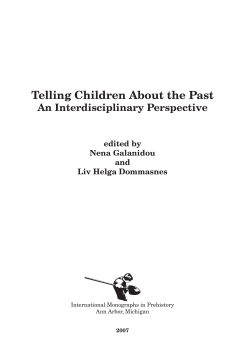
Additional Information
Book Details
Abstract
This book brings together archeologists, historians, psychologists, and educators from different countries and academic traditions to address the many ways that we tell children about the (distant) past. Knowing the past is fundamentally important for human societies, as well as for individual development. The authors expose many unquestioned assumptions and preformed images in narratives of the past that are routinely presented to children. The contributors both examine the ways in which children come to grips with the past and critically assess the many ways in which contemporary societies and an increasing number of commercial agents construct and use the past.
Liv Helga Dommasnes is a professor in the Department of Cultural History at University of Bergen.
Nena Galanidou is Associate Professor of History & Archaeology at University of Crete.
Table of Contents
| Section Title | Page | Action | Price |
|---|---|---|---|
| Telling Children About the Past | i | ||
| Copyright | ii | ||
| Contents | iii | ||
| Contributing Authors | v | ||
| Acknowledgements | ix | ||
| Dedication | xi | ||
| Introduction | xii | ||
| Part 1. Learning Paths | 15 | ||
| Chapter 1. Cognitive and Neural Developments that Make it Possible to Experience the Past as the Present | 17 | ||
| Chapter 2. Autobiography, Time and History | 42 | ||
| Chapter 3. Representing the Past in Pictures | 59 | ||
| Chapter 4. Children’s Understanding of Authenticity | 81 | ||
| Part 2. Contexts of Telling I | 101 | ||
| Chapter 5. Groovin’ to Ancient Peru | 103 | ||
| Chapter 6. Telling Children About the Past using Electronic Games | 125 | ||
| Chapter 7. In a Child’s Eyes | 145 | ||
| Chapter 8. Writing Prehistory for Children | 173 | ||
| Chapter 9. Museums and Archeological Sites as the Setting for Wondrous Tales | 187 | ||
| Part 3. Contexts of Telling II | 201 | ||
| Chapter 10. Exhibiting the Past to Children | 203 | ||
| Chapter 11. Eviscerating Barbie | 226 | ||
| Chapter 12. Conversations About the Past | 241 | ||
| Chapter 13. Small People versus Big Heritage | 259 | ||
| Chapter 14. Landscapes and Winter Counts | 277 | ||
| Chapter 15. Telling Children About the Past in Brazil | 291 | ||
| Chapter 16. From Fragments to Contexts | 312 |
